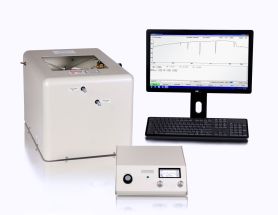Research
- Fabrication and study of properties of special optical glasses containing the ions of d- a f-elements
- Fabrication and study of properties of the K+, Ag+, Cu+, Cu2+ and Li+ optical waveguides in dielectric materials
- Study of properties of surface layers fabricated by ion implantation
- Diffusion processes occurred by ion exchange
- Localized doping of lasing active ions into glass substrates
Experiments
- Equipment for the preparation of optical glasses
= An optical glass melting furnace with a continuous operating temperature of 1,650 °C (max. temperature is 1,700 °C), a max. heating rate of 20 °C/1 min., lower crucible rotation and with an integrated Pt stirrer with upper rotation.

- Equipment for fabrication of optical waveguides by thermal ion exchange
- Equipment for the electric field assisted ion exchange
Measurements methods
M-line spectroscopy (Metricon Prism Coupler)
The Metricon Model Prism Coupler utilizes advanced optical waveguiding techniques to rapidly and accurately measure both the thickness and the refractive index/birefringence of dielectric and polymer films as well as refractive index of bulk materials at five wavelenghts (473, 633, 964, 1311 or 1552 nm). The method offers unique advantages over conventional refractometers and instruments based on ellipsometry or spectrophotometry.


The Metricon Model Prism Coupler, loss streak, 633 nm
- completely general knowledge of optical properties of film/substrate required,
- routine index resolution of ±.0005 (accuracy of up to ±.0001 available for many applications),
- routine index resolution of ±.0003 (resolution of up to ±.00005 available for many applications),
- high accuracy index measurement of bulk materials,
- rapid characterization of thin films or diffused optical waveguides,
- simple measurement of index vs wavelength,
- options to measure waveguide loss,
- wide index measurement range (1.0 – 3.35).
Dark Mode Spectroscopy (671 nm) & Prisms-coupling Mode Spectroscopy (632 nm)
Refractive index depth profile and parameters of surface optical layers (i.e. refractive index increment, surface refractive index n0)

Characterization of optical properties by the Prism-coupling Mode Spectroscopy (He-Ne laser, 632 nm), photo: Ales Novak
Optical Polarization Microscope
Control of surface quality, striae visualization and depths of the optical layers
Habilitation thesis
"Inorganic materials for photonics application" - P. Nekvindova, 2016
Recent and current dissertation thesis
"Metal nanoparticles tunable nanostructuring in glasses and glass ceramics: solid state chemistry, optical properties and nanostructure" - J. Baborák, 2023
"Laser-active silicate glass and fibers – the effect of glass matrix nanostructuring" - P. Vařák, 2023
"Study of nonlinear optical properties of metal nanoparticles prepared in inorganic materials" - S. Vytykacova, 2020
"Study of the luminescence properties of lanthanides in dielectric materials with respect to the crystal field influence" - J. Cajzl, 2019
"Development of novel erbium-ytterbium silicate glass for planar optical waveguide amplifier" - S. Stanek, 2018
Recent diploma thesis
"Decorative chrome-based thin films prepared by magnetron sputtering" - I. Venkrbcova, 2024
"The effect of optical basicity on luminescence properties of Ce and Mn ions in borate-silicate glasses" - J. Volf, 2023
"Gallium in the ZnO structure - fabrication and properties" - K. Jeníčková, 2021
"The study of optical properties of nanocrystal diamond thin films" - B. Akhetova, 2016
"Influence of silver metal nanoparticles on properties of glasses containing erbium ions" - B. Chladekova, 2016
"Fabrication of thin optical layer containing copper via sol-gel method, ion exchange and ion implantation" - P. Vařák, 2016
Collaborations
Institutes of Czech Academy of Science:
Nuclear Physics Institute Institute of Physics Institute of Photonics and Electronics Institute of Chemical Process Fundamentals
Faculty of Mathematics and Physics (Charles University Prague)
Czech Technical University in Prague:
Faculty of Electrical Engineering Faculty of Nuclear Sciences and Physical Engineering
